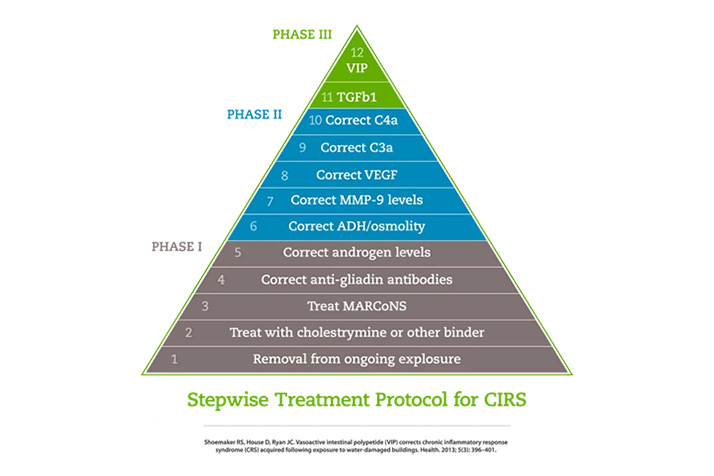CIRS in Annapolis
What Is CIRS?

One in four Americans (adults and children) have a genetic susceptibility towards Chronic Inflammatory Response Syndrome. It’s vital to understand the symptoms of CIRS.
Diagnosing this condition can even cause problems for professionals. The symptoms of CIRS are often misdiagnosed as fibromyalgia, ADHD, Chronic Fatigue Syndrome, and the list goes on.
Researchers even suggest that type 3 Alzheimer’s disease is a result of CIRS and should be treated accordingly. If not properly diagnosed, Alzheimer’s disease may be treated incorrectly.
What is CIRS?
CIRS stands for Chronic Inflammatory Response Syndrome. It is also called Biotoxin Illness. This is a multisystem, multi-symptom condition that occurs when mold biotoxins (like mycotoxins) attach to immune cells and don’t let go. In more recent years, we have also discovered other sources of biotoxins, which are essentially toxins created and released by living things. In addition to mold, this includes bacteria (in the environment, or in the body as in dental infections), algae (think standing water outside on lawns or in ponds, but also in home sump pumps), parasites, vaccines (cultured in infected cell lines that release toxins), etc.
In people with CIRS, normal elimination of fatty cholesterol-based toxins from these bio-sources don’t get eliminated from the bowels as they should, and the CIRS patient essentially re-absorbs them back into the body as though they were food, thereby keeping the toxins recirculating over and over through the body, attaching themselves to cell membranes, brain and nerve tissue, hormone receptors, etc triggering the immune system to constantly be in attack mode. A CIRS patient may have been exposed to mold or other biotoxins many years prior, but still can’t eliminate the toxins via bowels even after removing themselves from the source.
The immune cells keep sending signals to produce cytokines — proteins produced by your immune system to help kill and heal from attacks. When your immune system keeps producing cytokines, it grows weakened from being overworked. The main issue in CIRS patients is that they are continuously, chronically responding in an acute manner, as though they are attacking and responding to a ‘flu’ 24-7, 365 days a year, v.s. what should normally happen and that is stay shut off until handling an actual infection (i.e. 24-48 hour flu, etc.)
On top of that, all the excess immune response leads to your own immune system attacking benign (healthy) tissues, causing inflammation and potentially auto-immunity.
There are several common ways you can run into CIRS:
- Water-damaged building (home or office) (with known or hidden sources of toxic mold/bacteria)
- Tick bite-related diseases, such as Lyme disease
- Exposure to dinoflagellates (waterborne toxin producers) like Ciguatera or Pfiesteria
- Dental infections (crowns, root canals, old pockets where wisdom teeth have been previously removed
- Parasites (can live anywhere in the body)
- Moldy or contaminated food
- Vaccines (many are cultured in infected cell lines that produce their own toxins)
Dr. Ritchie Shoemaker spearheaded the discovery of and research into CIRS. Dr. Shoemaker was a family physician in Maryland when he linked an illness to a toxin produced by Pfiesteria.
Symptoms of CIRS In Annapolis
Chronic Inflammatory Response Syndrome is a multisystem, multi-symptom inflammatory illness. The symptoms of CIRS are systematically separated into 13 unique clusters. Since there are some symptoms of chronic mold exposure, such as weight gain, that do not apply specifically to CIRS, in this article, I will only discuss the symptoms specific to CIRS. Typically, if you exhibit eight of these symptoms (six if we’re talking about a child), you should get tested for CIRS.
- Abdominal Pain, Diarrhea, Numbness: A common inflammatory symptom of CIRS is abdominal pain. Though this is a symptom of many conditions, if it is coupled with other symptoms of CIRS, you may want to be tested for CIRS. Abdominal pain can also include diarrhea, leaky gut, or numbness.
- Disorientation, Tearing of the eyes, Metallic Taste: The symptom of disorientation can be grouped with a metallic taste in your mouth and constant watery eyes.
- Congested Sinuses, Shortness of Breath: CIRS has to do with breathing in mold. So it stands to reason that your nasal area would be affected. In fact, the research confirms this — the nose and sinuses are the primary suspects for the production of mycotoxins. Congested sinuses and shortness of breath are common symptoms of CIRS.
- Impaired Memory, Decreased Word Finding: CIRS and other mold exposures can impair your memory and make it difficult for you to find the right word in a normal conversation. In a 2014 study, researchers used a software program, called NeuroQuant, to link mold illness from water-damaged buildings with brain abnormalities, such as difficulty with recent memory.
- Body Aches, Weakness, Headache, Light Sensitivity, Decreased Assimilation of New Knowledge: If your body aches all the time, it can be a sign you may have Chronic Inflammatory Response Syndrome. Weakness, headaches, light sensitivity — all of these are closely related symptoms of CIRS.
- Skin Sensitivity, Tingling: Another of the more common symptoms, skin sensitivity can indicate Chronic Inflammatory Response Syndrome. This includes rash and pins and needles tingling. Skin sensitivity was the method by which researchers found that people who are present during hurricanes are more susceptible to mold allergies.
- “Ice-Pick Pain”, Red Eyes, Blurred Vision, Sweats, Mood Swings: One of the more wide-ranging clusters of symptoms. Joint Pain, Morning Stiffness, Cramps: If you are experiencing joint pain, it may be a symptom of CIRS — joint pain relief may be around the corner.
Morning stiffness is also a problem for those living with CIRS, clustered with muscle cramps. - Fatigue: CIRS can bring about fatigue that is deep and persistent. Fatigue is reported as a leading cause of low quality of life. If you suffer from chronic fatigue coupled with several other symptoms on this list, ask your doctor if you might have CIRS.
- Vertigo, Static Shocks: Vertigo and static shocks are clustered together as related effects of the havoc that mold illness can wreak on your immune system. Both are symptoms of CIRS.
- Difficulty Concentrating: Inhaling mold neurotoxins causes your immune system to overwork itself and contributes to inflammation all throughout your body, including your brain. This leads to CIRS patients having difficulty concentrating. Difficulty concentrating is one symptom that leads to a misdiagnosis like ADD or ADHD.
- Excessive Thirst, Cough, Confusion: Mold exposure can cause extreme thirst. Another symptom related to, but not dependent on, thirst is a recurring cough and confusion.
- Difficulty Regulating Body Temperature, Increased Urinary Frequency, Appetite Swings: If you have trouble regulating body temperature, you may be dealing with CIRS. The other symptom in this cluster is frequent urination, one of the symptoms shared between CIRS and fibromyalgia.
Testing and Treatment of CIRS
With so many misdiagnoses, it’s important to identify the symptoms, test for CIRS, then begin treatment of CIRS.
TESTING FOR CIRS
Healthcare professionals may administer urine or blood tests for CIRS biomarkers. Genetic testing will be done to determine genetic susceptibility and the type of CIRS patient. Acute inflammation markers (cytokines) such as TGF-B1 and C4a will also be run initially to determine if there is an immediate/current potential CIRS inflammation happening. Once initial screening is done and determined likely for CIRS, then the rest of the CIRS markers will be tested.
There is a protein, VEGF, that is not produced as efficiently in subjects dealing with mold infections. So, doctors may test for VEGF deficiency to determine if you are experiencing CIRS.
Mold illness will also reduce levels of the anti-inflammatory hormone called melanocyte-stimulating hormone (MSH). You can be tested for MSH levels as well.
The above tests are just a few of several CIRS biomarkers that can be tested. A Visual Contrast Sensitivity Test (VCS) may also be administered. This VCS Test measures your ability to see details at low contrast levels. It may be used as a nonspecific test of neurological function.
Once someone’s been diagnosed with CIRS, it’s important to rule in/out the environment for mold. An ERMI test is a great start to test your home and/or office for multiple different toxic molds and this can be done on your own. ERMI stands for Environmental Relative Moldiness Index. Though some companies have developed home test kits, the U.S. EPA originally designed this test only for labs.
In our office, something called Bio-Meridian Analysis testing (also called AMA testing – acupuncture meridian assessment) is often performed to rule in our out parasites, internal fungal/yeast, and dental infections as a potential biotoxin source that may need to be addressed. These are performed as per protocols created by Dr. Simon Yu MD and can be read about at www.preventionandhealing.com and visualized on his YouTube channel.
TREATMENT OF CIRS
The first and most important step is determining if there is a current mold/biotoxin exposure happening in the home/workplace and to get to handling that asap. This is done under the guidance of our office to ensure that proper handling of medical mold cases is done.
The treatment of CIRS from a conventional standpoint includes both prescription medications and supplemental support. An integrative approach emphasizes a change in diet and utilizing binders and antioxidants to remove unwanted toxins and stimulate the rebalancing of the immune system. Ozone and vitamin IV may be recommended depending on the clinical presentation of the patient.
The next major step in the process is to introduce natural binders such as specific fibers, okra pepsin, bentonite clay, or activated charcoal. These are consumable and effective tools to soak up toxins that the body is having difficulty eliminating. Prescription binders such as Cholestyramine and Welchol are often needed for a finite period initially to fully bind to the cholesterol-based toxins coming out in the bile.
Once on the binders and confirmed with VCS testing to be pulling toxins, then medications/herbs to handle parasites and internal mold/fungal growth is brought in, and dental infections that may need handling are also done.
Testing and removal of MARCoNS and mold from deep within the nose if present must be performed on many with CIRS. MARCoNS stands for Multiple Antibiotic Resistant Coagulase Negative Staphylococci (a bacteria common to us) that can overgrow deep in the sinuses when CIRS takes hold and becomes another critical source of biotoxins for the patient. Because MARCoNS can also move between sinuses and dental infections, the dental issue cannot be ignored, and vice-versa.
One of the final steps in CIRS treatment may include VIP nasal spray. VIP stands for vasoactive intestinal peptide, which decreases levels of biotoxins like MMP-9 and TGF-beta1. Physicians report a 90 percent success rate with VIP nasal sprays, as well as no reported adverse side effects.
In many circumstances, functional medicine encourages patients to go on a gluten-free diet for at least a few months. In others, patients may need to adhere to a low-amylose diet.
The No-Amylose Diet can yield great results in CIRS patients. The No-Amylose Diet eliminates:
- Bananas
- Grains
- Sugars
- Processed foods
- Foods grown underground, such as potatoes, carrots,
- and peanuts
This is a pyramid diagram of the basic steps in order of priority to follow with a CIRS patient. In our office/protocols, ‘removal from source’ may also include parasite elimination, handling of dental infections in addition to removal from the source of a moldy environment. All of these may need to be handled/addressed in order to get and keep a patient healthy.

In Summary
- CIRS (Chronic Inflammatory Response Syndrome) is a biotoxin illness when the biotoxins are not swiftly removed by your immune system, usually due to a genetic disposition common in a quarter or more of Americans. (The gene is named HLA-DR 1/3/4/5 DQ)
- CIRS is too often misdiagnosed as something else, and many with CIRS have multiple doctors from multiple specialties diagnosing them with multiple different ‘diseases’ while the common denominator to all of them may be Biotoxin Illness (i.e. depression, low hormones/libido, mental fog, neuropathy, auto-immunity, IBS/Crohn’s/Celiac, and our favorite, Fibromyalgia (which essentially just means pain of the muscle fibers
- The symptoms of CIRS are mainly inflammation-related
- Treatment of CIRS involves supplements, medication and lifestyle changes, as well as key handling of the environment.
Contact Living Health Integrative Medicine, LLC
If you suspect you have CIRS or are looking for a Team of Providers knowledgeable in Mold Illness and CIRS in the Maryland, DC, Virginia area, call us at (410) 216-9180 or complete our booking form online.
Sources
- Bredesen, D. E. (2016). Inhalational Alzheimer’s disease: an unrecognized—and treatable—epidemic. Aging (Albany NY), 8(2), 304. Full text: https://www.ncbi.nlm.nih.gov/pmc/articles/PMC4789584/
- Zhang, J. M., & An, J. (2007). Cytokines, inflammation and pain. International anesthesiology clinics, 45(2), 27. Full text: https://www.ncbi.nlm.nih.gov/pmc/articles/PMC2785020/
- Ryan, J. C., Wu, Q., & Shoemaker, R. C. (2015). Transcriptomic signatures in whole blood of patients who acquire a chronic inflammatory response syndrome (CIRS) following an exposure to the marine toxin ciguatoxin. BMC medical genomics, 8(1), 15. Full text: https://www.ncbi.nlm.nih.gov/pmc/articles/PMC4392619/
- Lichtenstein, J. H. R., Hsu, Y. H., Gavin, I. M., Donaghey, T. C., Molina, R. M., Thompson, K. J., … & Brain, J. D. (2015). Environmental mold and mycotoxin exposures elicit specific cytokine and chemokine responses. PloS one, 10(5), e0126926. Full text: https://www.ncbi.nlm.nih.gov/pmc/articles/PMC4444319/
- Brewer, J., Thrasher, J., & Hooper, D. (2014). Chronic illness associated with mold and mycotoxins: is naso-sinus fungal biofilm the culprit?. Toxins, 6(1), 66-80. Full text: https://www.ncbi.nlm.nih.gov/pmc/articles/PMC3920250/
- Al‐Ahmad, M., Manno, M., Ng, V., Ribeiro, M., Liss, G. M., & Tarlo, S. M. (2010). Symptoms after mould exposure including Stachybotrys chartarum, and comparison with darkroom disease. Allergy, 65(2), 245-255. Full text: https://www.ncbi.nlm.nih.gov/pubmed/19796210
- Kilburn, K. H. (2003). Indoor mold exposure associated with neurobehavioral and pulmonary impairment: a preliminary report. Archives of Environmental Health: An International Journal, 58(7), 390-398. Full text: https://ncbi.nlm.nih.gov/pubmed/15143851
- Shoemaker, R. C., House, D., & Ryan, J. C. (2014). Structural brain abnormalities in patients with inflammatory illness acquired following exposure to water-damaged buildings: a volumetric MRI study using NeuroQuant®. Neurotoxicology and teratology, 45, 18-26. Full text: https://www.ncbi.nlm.nih.gov/pubmed/24946038
- Saporta, D., & Hurst, D. (2017). Increased Sensitization to Mold Allergens Measured by Intradermal Skin Testing following Hurricanes. Journal of environmental and public health, 2017. Full text: https://www.ncbi.nlm.nih.gov/pmc/articles/PMC5401734/
- Huang, S. W., & Kimbrough, J. (1996). 1026 Mold allergy is a risk factor for persistent cold-like symptoms in children in winter. Journal of Allergy and Clinical Immunology, 97(1), 439. Full text: https://www.ncbi.nlm.nih.gov/pubmed/9415837
Paisley, P., & Serpell, M. (2016). Controlling joint pain in older people. Practitioner. Full text: https://www.ncbi.nlm.nih.gov/pubmed/27180497 - Roberts, D. (2018). Chronic fatigue syndrome and quality of life. Patient related outcome measures, 9, 253. Full text: https://www.ncbi.nlm.nih.gov/pmc/articles/PMC6078083/
- Magnus, W., & Anilkumar, A. C. (2019). Attention Deficit Hyperactivity Disorder (ADHD). In StatPearls [Internet]. StatPearls Publishing. Full text: https://www.ncbi.nlm.nih.gov/books/NBK441838/
- Stormorken, H., & Brosstad, F. (2005). Frequent urination–an important diagnostic marker in fibromyalgia. Tidsskrift for den Norske laegeforening: tidsskrift for praktisk medicin, ny raekke, 125(1), 17-19. Full text: https://www.ncbi.nlm.nih.gov/pubmed/15643456
- Kontoyiannis, D. P. (2010). Manipulation of host angioneogenesis: a critical link for understanding the pathogenesis of invasive mold infections?. Virulence, 1(3), 192-196. Full text: https://www.ncbi.nlm.nih.gov/pmc/articles/PMC3073245/
- Hope, J. (2013). A review of the mechanism of injury and treatment approaches for illness resulting from exposure to water-damaged buildings, mold, and mycotoxins. The Scientific World Journal, 2013. Full text: https://www.ncbi.nlm.nih.gov/pmc/articles/PMC3654247/
- Shoemaker, R., Katz, D., Ackerley, M., Rapaport, S., McMahon, S., Berndtson, K., & Ryan, J. (2017). Intranasal VIP safely restores volume to multiple grey matter nuclei in patients with CIRS. Int Med Review, 3(4). Full text: https://internalmedicinereview.org/index.php/imr/article/view/412


